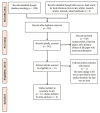Can Feeding a Millet-Based Diet Improve the Growth of Children?-A Systematic Review and Meta-Analysis
- PMID: 35011100
- PMCID: PMC8747143
- DOI: 10.3390/nu14010225
Can Feeding a Millet-Based Diet Improve the Growth of Children?-A Systematic Review and Meta-Analysis
Abstract
Undernutrition, such as stunting and underweight, is a major public health concern, which requires multi-sectoral attention. Diet plays a key role in growth and should optimally supply all required nutrients to support the growth. While millets (defined broadly to include sorghum) are traditional foods, and climate smart nutritious crops, which are grown across Africa and Asia, they have not been mainstreamed like rice, wheat, and maize. Diversifying staples with millets can potentially provide more macro and micro nutrients, compared to the mainstream crops. However, there is little known scientific evidence to prove millets' efficacy on growth. Therefore, a systematic review and meta-analysis was conducted to collate evidence of the benefits of millets in improving the growth of children. Eight eligible randomized feeding trials were included in the meta-analysis. Results from the randomized effect model showed a significant effect (p < 0.05) of millet-based diets on mean height (+28.2%) (n = 8), weight (n = 9) (+26%), mid upper arm circumference (n = 5) (+39%) and chest circumference (n = 5) (+37%) in comparison to regular rice-based diets over for the period of 3 months to 4.5 years, which was based on largely substituting rice with millets. When an enhanced and diverse diet was served, replacing rice with millet had only minimal growth improvement on chest circumference (p < 0.05). The quality assessment using GRADE shows that the evidence used for this systematic review and meta-analysis had moderate quality, based on eight scoring criteria. These results demonstrate the value of adding millet as the staple for undernourished communities. Further understanding of the efficacy of millets on growth in a wider range of diets is important to develop appropriate dietary programs and improve the nutritional status of various age groups across Africa and Asia.
Keywords: adolescent growth; height; infant growth; millets; weight.
Conflict of interest statement
The authors declare no conflict of interest.
Figures









References
-
- WHO Fact Sheets-Malnutrition–WHO. 2021. [(accessed on 1 July 2021)]. Available online: https://www.who.int›Newsroom›Factsheets›Detail.
-
- WHO Fact Sheets. 2018. [(accessed on 1 July 2021)]. Available online: https://www.who.int›Newsroom›Factsheets›Detail.
-
- Pem D. Factors affecting early childhood growth and development: Golden 1000 days. Adv. Pract. Nur. 2015;1 doi: 10.4172/2573-0347.1000101. - DOI
-
- NHFS-5 Ministry of Health and Family Welfare. National Health Family Survey 5 (2015–2020) 2020. [(accessed on 3 July 2021)]. Available online: http://www.rchiips.org/nfhs/pdf/NFHS5/India.pdf.
-
- Awika J.M. Major cereal grains production and use around the world. In: Awika J.M., Piironen V., Bean S., editors. Implications to Food Processing and Health Promotion, Advances in Cereal Science. American Chemical Society; Washington, DC, USA: 2011. pp. 1–13.
Publication types
MeSH terms
Grants and funding
LinkOut - more resources
Full Text Sources
Medical

